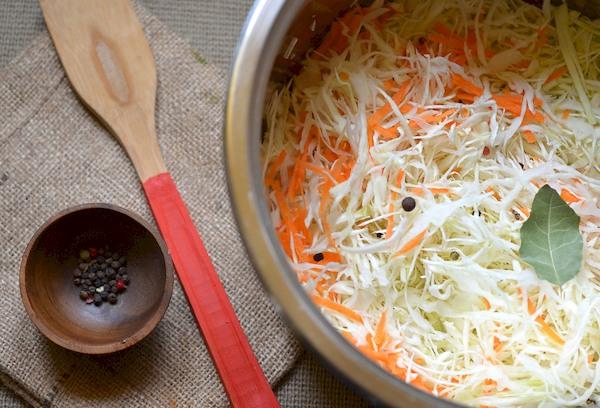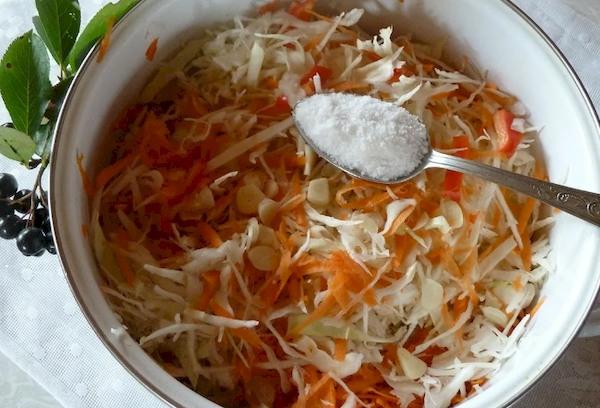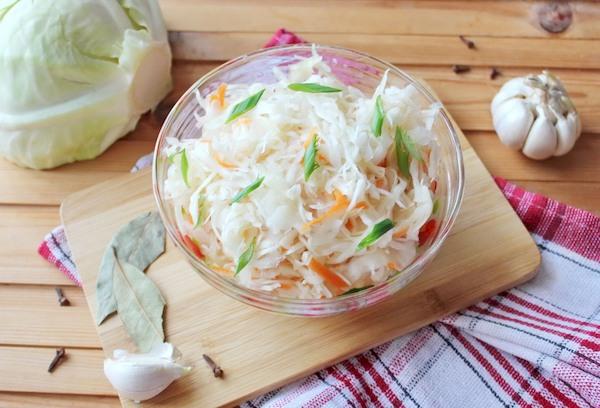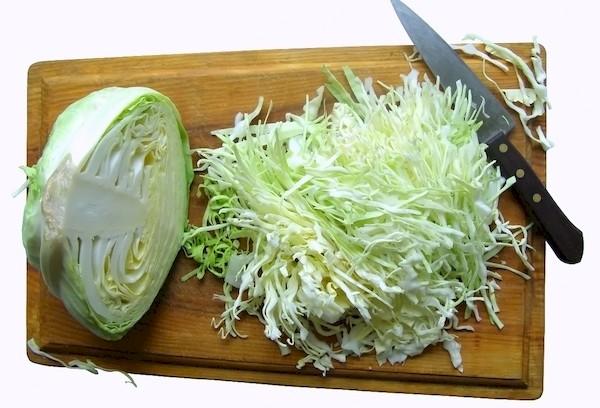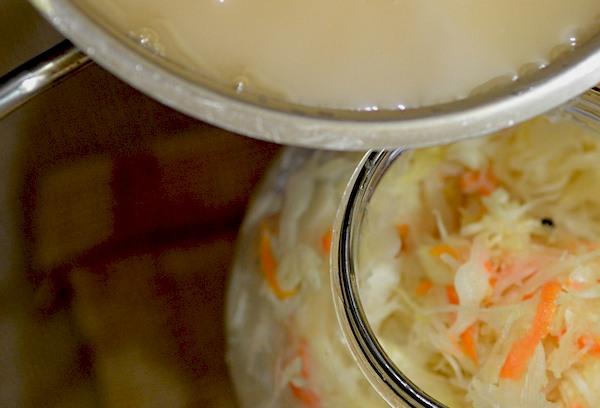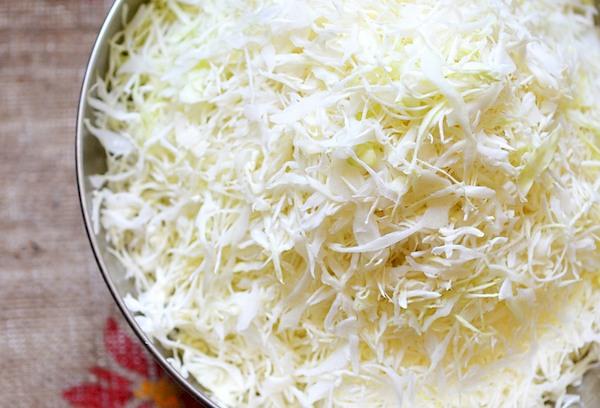What to do if sauerkraut is bitter: the main reasons
Crispy sauerkraut is great for side dishes for many dishes and contains many vitamins. But sometimes sauerkraut tastes bitter. It is important to understand the reason for this and, if possible, eliminate it so that the finished product is suitable for consumption.

Reasons why cabbage tastes bitter
If some mistakes were made during the cooking process, including choosing the main ingredients incorrectly, then the cabbage becomes bitter. This affects the fact that the fermentation process is not as active as required, harmful microorganisms begin to multiply, giving an unpleasant taste.
The piercing procedure was not performed before salting
If the piercing procedure is neglected before salting, the cabbage acquires a bitter taste. During pickling, cabbage juice and salt begin to interact with each other, resulting in an acidic environment in the container. During fermentation, gases appear that cannot escape on their own. As a result, gases accumulate in the cabbage, which in turn acquires an unpleasant odor, which negatively affects its taste.
This can be prevented by doing the following:
- Before starting the cooking process, it is recommended to pierce the head of cabbage in several places using a wooden stick.Thanks to this, gases can escape unhindered during the fermentation process.
- When the cabbage begins to ferment, you need to use a wooden stick to pierce the contents of the container, preferably to the very bottom. You need to do this 2-3 times daily.
If you follow these simple steps, carbon dioxide will escape without negatively affecting the taste of the product.
Advice! If, after the cabbage is placed in a container, a wooden stick is inserted in the center, it will absorb bitterness and other unpleasant odors.
Lots of salt
A fairly common reason why sauerkraut acquires a bitter taste is a large amount of salt. At room temperature, the natural fermentation process begins, which is caused by the interaction of salt with cabbage juice. As a result, lactic acid bacteria begin to form. However, if there is an excess of salt, the vital activity of bacteria becomes worse, most of them die, and as a result, fermentation slows down. If this happens, you will notice that the characteristic foam cap has not formed on the surface, the color has become gray, and the taste has deteriorated significantly.
You can correct the situation by doing the following:
- Carefully drain some of the brine from the container and add clean cold water.
- If about 24-48 hours have passed since salting, then you can add a certain amount of fresh cabbage, mix everything thoroughly and leave to ferment in a warm place.
However, do not be upset if it was discovered that the product was over-salted too late. In this case, cabbage can be used to prepare borscht, pies, and vinaigrette.
Not enough salt
You also need to understand that the product gets a bitter taste even if less salt is added than required. The active fermentation process occurs only in warm conditions, when the juice interacts with salt. If there is very little salt, then inside the container with cabbage the environment necessary for fermentation in which lactic acid bacteria will multiply will not be able to form. On the contrary, harmful bacteria begin to multiply and become very active, causing the product to rot.
You can understand that there is not enough salt by certain signs:
- The pieces of cabbage have acquired a gray tint.
- The cabbage has become too soft.
- When taking a sample, no salt is felt.
- When opening the container, an unpleasant odor is felt.
- The cabbage was covered in slime.
If the problem was identified early, it can be eliminated. To do this, it will be enough to add salt. First of all, part of the brine is drained and a new one is prepared, thanks to which it will be possible to stimulate fermentation. If this problem is noticed after a few days, when the cabbage turns gray, becomes soft and mucus appears, then nothing can be fixed, and as a result you will have to get rid of the cabbage. After all, it has become not only bitter in taste, but also harmful to the body.
Attention! If we consider the standard recipe for sauerkraut, then for every 10 kg of vegetables there should be 0.2 kg of salt.
Wrong cabbage variety selected
Medium and late varieties of cabbage are best suited for pickling. Early varieties are quite loose, with thin, green leaves. Early vegetables are great for making fresh salads. Considering that the amount of sugar in the composition is minimal, the product acquires a bitter taste after fermentation.
For pickling, it is recommended to use dense and white heads of cabbage, which contain a sufficient amount of sugar, due to which the required percentage of juice is released for the ferment. The sweet taste combined with salt gives the finished dish an indescribable taste.
Cabbage cut at the wrong time
Another common reason why the finished product becomes bitter is that the heads of cabbage are cut from the garden at the wrong time. In order for sauerkraut to not taste bitter, it must be fully ripe.
To choose the right cabbage, you should adhere to the following recommendations:
- It is recommended to cut cabbage at least 2 days after the first frost occurs. It is at this point that the vegetable finally ripens and is best suited for pickling.
- The cabbage head must be firm; if you press on it, you should hear a slight cracking sound.
- The color is necessarily white, which indicates that the leaves contain a large amount of sugar.
- The stump tastes sweet, dense, crispy.
Advice! After the head of cabbage has been cut, you need to let it sit for 7 to 14 days, which will allow the cabbage to finally gain maturity.
Ways to get rid of bitterness
In order to prevent the appearance of undesirable taste qualities, it is recommended to study in advance how to properly prepare sauerkraut. However, if some important points are missed and a mistake is made, then do not be upset, since in most cases everything can be corrected and the bitterness removed.
Let's look at the main ways to get rid of the unpleasant taste of sauerkraut:
- Place the cabbage on a tray and leave for a while to air out.Air circulation is important, so it is recommended to stir the cabbage as often as possible.
- Use bitter cabbage to make snacks. But to do this you will have to squeeze the juice well, then add granulated sugar, vinegar, vegetable oil and onion to taste. This snack can be stored in jars in the refrigerator.
- Prepare borscht, cabbage soup, fry or stew. The bitter taste is lost during heat treatment.
- Drain all the marinade, then pour in a new brine based on water, salt, and sugar. Of course, after this, the aroma will practically disappear, but along with it the bitterness from the finished product will also disappear.
Important! If you plan to prepare a new brine, then the amount of salt and sugar should be the same.

